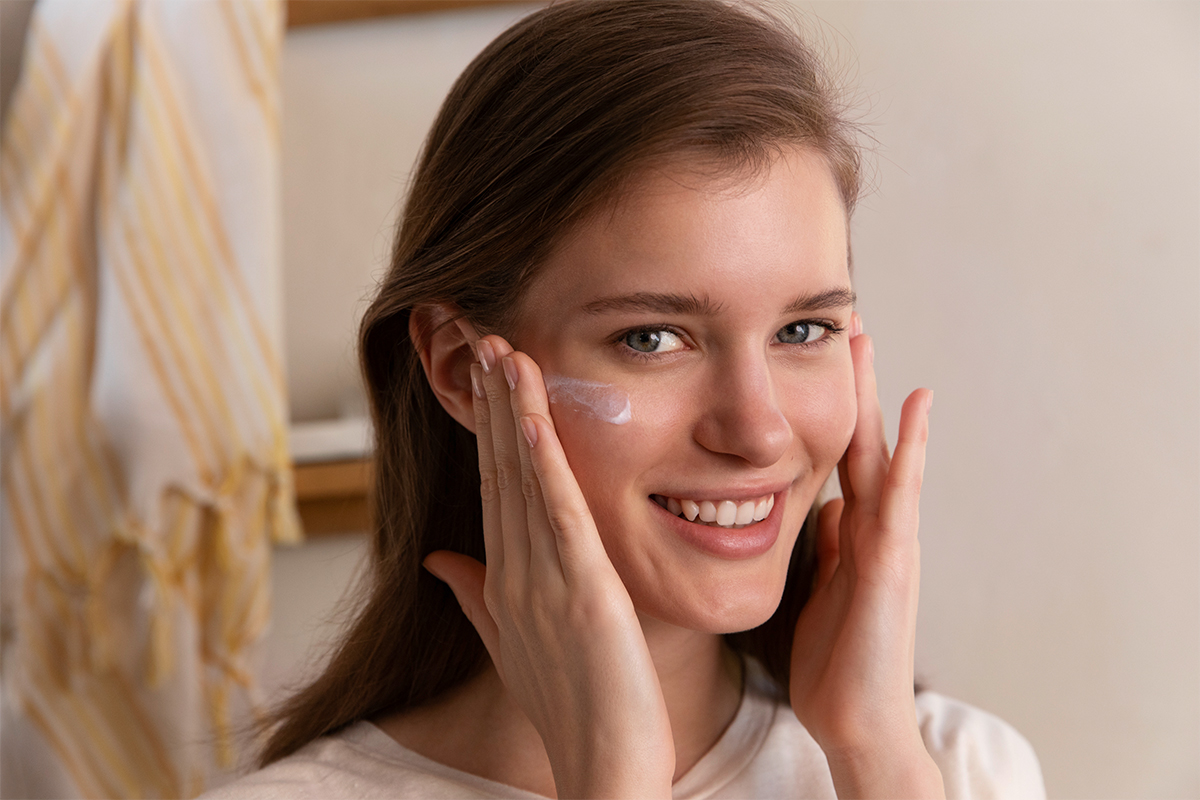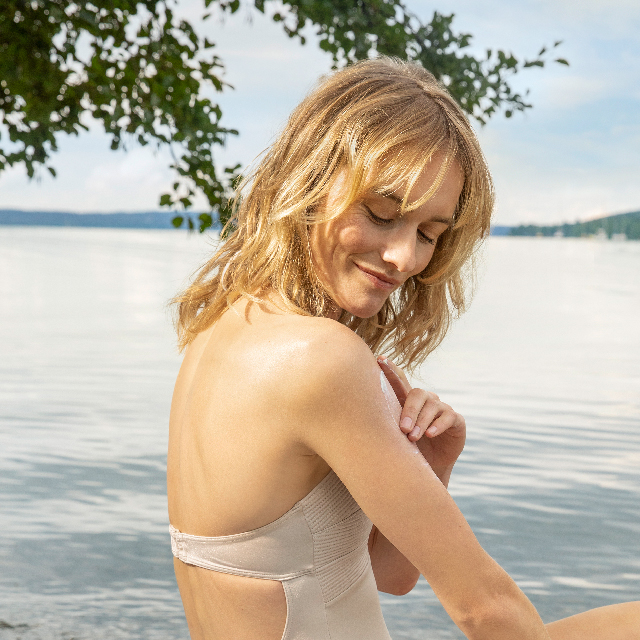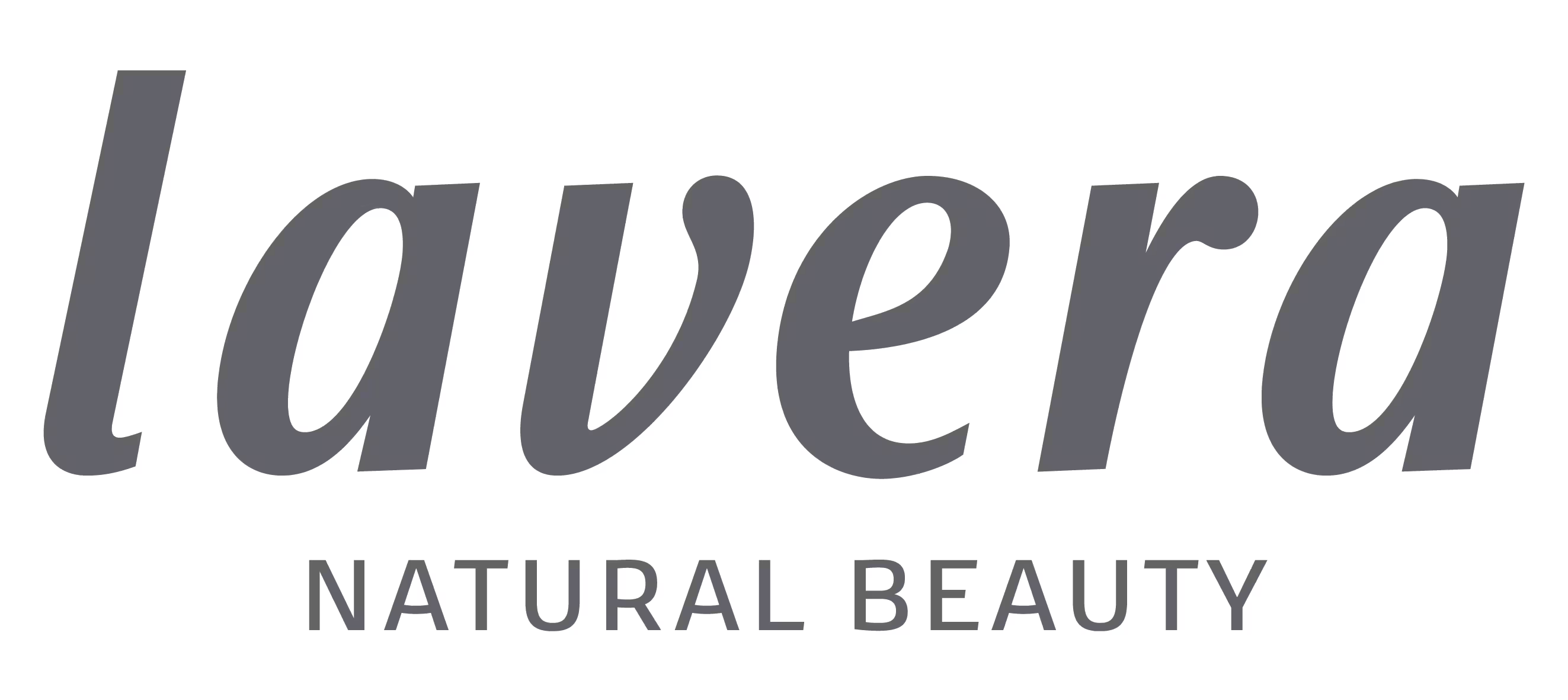
Mineral sun protection filter
In specialist circles, the mineral sun protection filter developed by lavera is known as physical sun protection. Our eyes detect the minerals – the pigments in the emulsion – as a white shimmer because of the way it reflects light on the skin, which means that the skin appears whiter and less shiny than when using synthetic sunscreens.
More about UV radiation
Sun is good in moderation. Its light is our most valuable source of the essential vitamin D, and its warmth makes most people feel good. Besides all its positive effects, the sun also has a darker side: Most of the damage to our skin and also a significant part of skin ageing is caused by sunlight, in other words, by UVA and UVB rays. And why it is so important to adequately protect our skin against them.

UVB rays
Short-wave UVB rays (290 to 320 nanometres) penetrate the uppermost layer of the skin, the epidermis, and damage the cells. They tan our skin and also cause sunburn.
UVA rays
Long-wave UVA rays (320 to 400 nanometres) penetrate much deeper into the skin and can trigger structural changes in the skin layers. The result is premature ageing of the skin. UVA rays also intensify the harmful effects of UVB rays, increasing the risk of sunburn and even skin cancer.
Mallorca acne
This typically manifests itself as small but extremely itchy spots, pimples or nodules on the skin, mainly on the upper body. Women between the ages of 20 and 40 are affected more than most. The cause of Mallorca acne has not yet been researched, but the trigger is likely to be the interaction of UVA rays and the oily components of conventional sunscreens. For people prone to Mallorca acne, we recommend using mineral products such as lavera Sensitiv Sun Creams.
Sun allergy
Mallorca acne is often confused with a sun allergy. The trigger in this case, however, is not the wrong type of sun protection. It is more likely caused by not using any sun protection products at all. The unprotected skin reacts in a hypersensitive way. It is not yet known why some people react like this.

Skin types & exposure to the sun
Skin type 1
Very fair skin with freckles, often blue eyes and reddish or light-blonde hair. After about 5 to 10 minutes in the midday sun, this skin type will get sunburned. This skin type doesn’t usually tan either.
Skin type 2
Fair skin and grey, green or blue eyes and blonde or dark-blonde hair. The skin reddens after about 10–20 minutes if it is not used to the sun. This skin type only tans slowly, the degree of tanning is minimal.
Skin type 3
Darker white skin, usually has dark-blond or light-brown hair and grey or brown eyes. This skin type can stay in the sun for about 20 to 30 minutes before sunburn occurs.
Skin type 4
This type of skin is light-brown or olive in colour and is largely unaffected by sunburn, usually has dark hair and brown eyes and tans easily. The skin only reddens after more than 30 minutes of sunbathing.
Skin type 5
Has light-brown or dark-brown skin, brown eyes and black hair and tans quickly in the sun. This skin type rarely ever burns, the natural self-protection time is more than 90 minutes.
Skin type 6
This skin type has dark brown skin, which quickly tans darkly when sunbathing. Practically never gets sunburned. The natural self-protection is more than 90 minutes and usually exceeds that of skin type 5.
What is sun protection factor?
The sun protection factor (SPF) indicates how well a sunscreen product protects against UVB radiation. Products show both the SPF as a numerical value and the corresponding protection class (e.g. “high” or “very high”). Even sunscreens with a very high sun protection factor do not offer 100% protection against UV radiation.
Our Innovation: A Lightweight Anti-UV Fluid with Mineral Sun Protection
The lavera Anti-UV Fluid SPF 30 acts like an invisible film on your skin, instantly and reliably reflecting UV rays. It not only prevents early signs of sun-induced skin aging, such as fine lines and pigmentation spots, but also ensures a smooth skin feeling. The fluid is a perfect companion for all skin types (including sensitive skin) throughout the year. The protective and moisturizing properties, along with the use of mineral sun protection, make the Anti-UV Fluid SPF 30 a true innovation in natural cosmetics.
The Hawaii Reef Law
Law Did you know that approximately 14,000 tons of sunscreen end up in the oceans worldwide each year? The ingredients often used in sunscreens, octinoxate and oxybenzone, are particularly problematic. These substances persist in the environment and can harm animals and plants. Additionally, they are suspected of affecting human health.
To protect the ocean and reefs, Hawaii became the first U.S. state to pass the so-called Hawaii Reef Law in 2018. Effective January 2021, this law prohibits the sale of sunscreens containing the synthetic UV filters octinoxate and oxybenzone locally.
To reduce the burden on the seas from these two synthetic UV filters, we recommend using sunscreen products with mineral UV protection. For the sake of the environment, our sunscreen products have been formulated with purely mineral UV filters for more than 30 years. This makes them compliant with the Hawaii Reef Law.
Apply generously to the skin before sunbathing. For an average-sized adult, this is about 20–30 ml (6 teaspoons). Smaller application quantities reduce the level of protection. Even sunscreens with a very high sun protection factor do not offer 100% protection against UV radiation. So do not stay in the sun too long and avoid the midday sun when UV is strongest, even when using sunscreen.
Sensitive baby and children’s skin should not be exposed to direct sunlight. We recommend a fragrance-free sunscreen for small children from 6 months of age, such as lavera Sensitiv Sun Lotion KIDS SPF 50. Children’s skin is thinner than adults’ skin, it cannot form as many pigments, so it has less natural protection. This is why a very high sun protection factor is very important for sensitive children’s skin. Use protective clothing and headgear in addition to a sunscreen product. Basically, loose, dark clothing provides better protection than tight, light clothing.
Almost half of the UV radiation still reaches the skin in the shade. Water and sand reflect the sun’s rays, increasing the risk of sunburn. So, the same thing applies here: Always use a sunscreen!
Even thirty centimetres under the water our skin is still exposed to UV radiation. While swimming, the water keeps the skin cool even though the sun’s rays still reach it, giving the impression that the skin is safe from UV rays. And why you should use waterproof sun creams.
To keep the desired level of protection, especially after swimming, sweating or rubbing with a towel, sunscreen should be reapplied. Make sure you reapply regularly.
Nanomaterials are chemical substances or materials with a particle size of 1 to 100 nanometres (nm) in at least one dimension. Since the EU Cosmetics Regulation came into force in 2013, these particles must be declared in the list of ingredients of sunscreens with the term “nano”*, e.g. zinc dioxide (nano)*.

Do something good for yourself and the environment!
The natural compositions of our active ingredients provide reliable protection without irritating the skin. A large portion of the sustainable packaging is made of recycled materials and the sunscreen formula is compliant with Hawaiian reef law.






